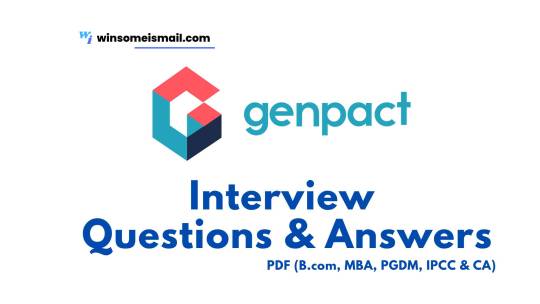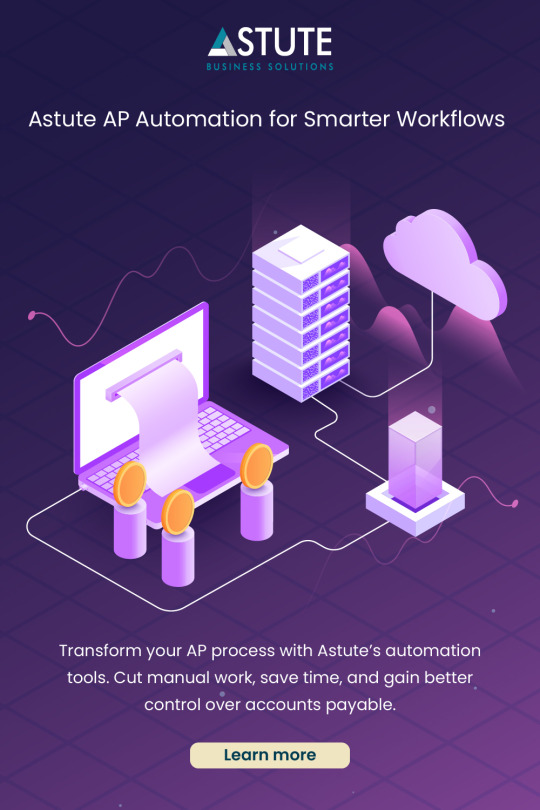#AccountsPayable
Explore tagged Tumblr posts
Text
Genpact - Finance Genpact Interview Questions & Answers PDF
Here I am sharing Genpact Interview Questions and Answers for the role, like Accounts payable, receivable, Business analyst and more...
Genpact - Finance Genpact Interview Questions & Answers PDF
#Genpact #AccountsPayable #GenpactJobs #GenpactInterview #GenpactFinanceJobRoles
Securing your dream job in today's competitive job market can be a challenging journey. With the landscape of job interviews constantly evolving, it's essential to have the right tools to help you shine during the Genpact interview questions.
One powerful resource that can significantly enhance your chances of acing an interview is an interview question set. In this blog post, we'll break down why investing in the Genpact Interview Questions and Answers set PDF is a smart move for your career.

In this blog post, we'll delve into the compelling reasons why investing in the "Genpact Interview Questions Set PDF File" is a wise decision for your career.
Finance Genpact Interview Questions
Q1. Goods reconciliation note
Reconciliation under Goods & Services Tax (GST) is about matching the data filed by the supplier with those of the recipients and recording all the transactions that have taken place during that period. The reconciliation process ensures that no sales or purchases are omitted or wrongly reported in the GST returns.
Q2. What is the difference between a ledger and a subsidiary ledger?
A ledger is a book containing accounts (classified and summarised from a journal) and posted as debits and credits. Called the secondary book of entries.
contains information that is required to prepare financial statements. It includes accounts like asset liabilities, owners’ equity revenues, and expenses.
Prepaid expenses
Prepaid rent, a/c,
To cash….a/c
Prepaid expenses represent expenditures that have not yet been recorded by a company as expenses but have been paid for in advance. In other words, prepaid expenses are expenditures paid in one accounting period that will not be recognized until a later accounting period. Prepaid expenses are initially recorded as assets because they have future economic benefits and are expensed at the time when the benefits are realized (the matching principle).
● Prepaid expenses are future expenses that are paid in advance and hence recognized initially as an asset.
● As the benefits of the expenses are recognized, the related asset account is decreased and expensed.
● The most common types of prepaid expenses are prepaid rent and prepaid insurance.
● Company A signs a one-year lease on a warehouse for $10,000 a month. The landlord requires that Company A pay the annual amount ($120,000) upfront at the beginning of the year.
The initial journal entry for Company A would be as follows:
Prepaid rent a/c...dr 120000
To cash….a/c
Q3. What are the accounting principles and assumptions?
• Economic entity assumption: The economic entity assumption is an accounting principle that separates the transactions carried out by the business from those of its owner.
• Monetary unit assumption: All financial transactions should be recorded in the same currency.
• Specific period assumption: Financial reports should show results over a distinct period.
• Cost principle: The cost of an item doesn’t change in financial reporting.
• Full disclosure principle: All information that relates to the function of a business’s financial statements must be disclosed in notes accompanying the statements.
• Going concern principle: A business will continue to exist and function with no defined end date.
• Matching principle: Businesses should use the accrual basis of accounting and report all financial information using this method.
• Revenue recognition principle: Revenue is reported when it’s earned, regardless of when payment is received.
• Materiality principle: When an accountant finds a transactional error, they can use their professional judgment to determine if the error is immaterial to the business.
• Conservatism principle: When there is more than one acceptable way to record a transaction, expenses and liabilities should be recorded as soon as possible, and revenues and gains should only be recorded when they occur.
Q4. What is an outstanding expense? Example: What is an entry?
The outstanding expenses are certain expenses that are incurred but not paid. These outstanding expenses are related to a given accounting period and are not paid in the same period. … As the journal entry for the outstanding expenses is posted, they are then placed appropriately in the final accounts.
The accounting rule applied is to “credit the increase in liability” and “debit the increase in expense,” as chalked out by the modern rules of accounting.

Read Full Article - https://winsomeismail.com/genpact-interview-questions-answers-pdf/
#receivable#Genpact#AccountsPayable#GenpactJobs#GenpactInterview#GenpactFinanceJobRoles#winsome ismail
1 note
·
View note
Text
Top Outsourced Bookkeeping Firm in India Acumen Financial Solutions
Acumen Financial Solutions is one of the most trusted outsourced bookkeeping firms in India, delivering accurate and efficient financial record-keeping for startups, SMEs, and enterprises. Our services include ledger maintenance, transaction recording, bank reconciliation, accounts receivable/payable, and monthly financial reporting. By outsourcing your bookkeeping to us, you save time, lower operational costs, and ensure regulatory compliance. We use advanced software tools and a skilled team to deliver timely and error-free reports that support better decision-making. Whether you're scaling or stabilizing, Acumen provides the expert bookkeeping support your business needs to grow confidently.
0 notes
Text
#ProcureToPay#P2PAutomation#SourceToPay#DigitalProcurement#CostReduction#AccountsPayable#ProcessOptimization
1 note
·
View note
Text
Streamline Your Finances with Expert Accounts Payable Services

Managing your business finances is easier with professional Accounts Payable Services from Aone Outsourcing. Our experts ensure accurate invoice processing, timely payments, and seamless vendor management. By outsourcing to Aone Outsourcing, you reduce errors, save time, and improve cash flow. Whether you're a small business or a large enterprise, our tailored Accounts Payable Services help you stay organized and efficient. Trust Aone Outsourcing for reliable, cost-effective solutions that streamline your financial operations.
1 note
·
View note
Text
Automate Accounts Payable for Smarter Workflow
Cut costs and gain better control with Accounts Payable automation. Eliminate paper invoices and manual data entry. Speed up your workflow, ensure compliance, and transform your AP process. Explore the benefits now!
0 notes
Text
Understanding Treasury Management in the Modern Corporate World
An integral part of any organization's financial operations, treasury management refers to the processes, systems, strategies, and controls employed to effectively manage an entity's liquidity, payments, collections, cash positioning, and associated financial risks. At its core, treasury management aims to use an organization's capital in the most efficient way possible to support daily operations and long-term growth goals. A treasury manages payment of suppliers, vendors, contractors and employees accurately and on time. They implement payment solutions and platforms for smooth electronic payment processing both domestic and cross-border.
Get More Insights on Treasury Management https://www.patreon.com/posts/treasury-cash-129896625

#TreasuryManagement#CashFlow#ERP#AccountsReceivable#AccountsPayable#WorkingCapital#CoherentMarketInsights
0 notes
Text

OnlineCheckWriter.com - powered by Zil Money is a Melio Payments Alternative, enabling businesses to handle accounts payable with credit cards, even where cards aren't accepted. Enjoy efficient payments and rewards.
Learn more: https://onlinecheckwriter.com/melio-payments-alternative/
Click Here for Interactive Demo: https://onlinecheckwriter.storylane.io/share/kqx1f9jgwna5
0 notes
Text
#B2BPayments#DigitalPayments#FintechSolutions#PaymentAutomation#AccountsPayable#AccountsReceivable#CorporatePayments#PaymentInnovation#BusinessTransactions#FinancialTechnology
0 notes
Text
Basics of Accounts Payable and Accounts Receivable: What Every Accountant Must Know

Cash coming in and out are the two unseen motors that power any firm. These engines are a treasure trove for accountants. The foundation of this apparatus is made up of accounts payable (AP) and accounts receivable (AR). The system will malfunction if you mess things up. If you master them, you'll be the unsung hero responsible for efficient operations. Let's go past the technicalities and explain what these phrases represent, how they operate in India, and why they are essential to financial stability.
Accounts Payable vs Accounts Receivable
Consider accounts payable as your "to-pay" file. It is the debt your company owes suppliers, vendors, or tax authorities. Conversely, accounts receivable is your "to-collect" list—the money people owe you for goods or services supplied. Straight forward? Not rather. In India, where vendor negotiations, TDS deductions, and GST compliance rule, AP and AR necessitate accuracy.
Accounts Payable Cycle: Starts when you receive a bill or invoice. Verify it (check GST details, purchase order matching), approve it, schedule payment (factoring in credit terms like ��Net 30”), and finally, record the transaction. One slip-up here—like missing a TDS cut-off—can mean penalties or pissed-off suppliers.
Accounts Receivable Cycle: Begins with invoicing clients. Send the bill (with proper GSTIN and HSN codes), track due dates, follow up relentlessly (because late payments are an epidemic), and log receipts. Missed follow-ups? Say hello to cash crunches.
The difference? AP is about managing outflows (don’t pay late, but don’t pay too early either). AR is about accelerating inflows (get cash faster, always). Both cycles keep the business alive.
Accounts Payable Journal Entries: Recording the Outflow
Every rupee leaving the company needs a paper trail. Let’s say you buy raw materials worth ₹1,00,000 from a vendor, with 18% GST. Here’s how it looks:
Purchase Entry:
Debit: Purchase Account – ₹1,00,000
Debit: GST Input Credit – ₹18,000
Credit: Accounts Payable – ₹1,18,000
Payment Entry (when you clear the dues):
Debit: Accounts Payable – ₹1,18,000
Credit: Bank Account – ₹1,18,000
Forget to reverse input credits? The taxman will hunt you down.
Accounts Receivable Journal Entries: Tracking the Inflow
Sold goods worth ₹2,50,000 to a client with 12% GST? Here’s the drill:
Sales Entry:
Debit: Accounts Receivable – ₹2,80,000
Credit: Sales Account – ₹2,50,000
Credit: GST Output Liability – ₹30,000
Receipt Entry (when payment lands):
Debit: Bank Account – ₹2,80,000
Credit: Accounts Receivable – ₹2,80,000
Pro tip: Always reconcile AR balances with GST returns. Mismatches? Instant red flags during audits.
Accounts Payable Management
Managing AP isn’t about paying bills on time. It’s strategy.
Negotiate Terms: Stretch payment periods without burning vendor relationships. “Net 45” instead of “Net 30”? Yes, please.
Leverage Discounts: Some suppliers offer 2% off for early payments. Crunch the numbers—sometimes saving ₹2,000 on a ₹1 lakh bill beats holding cash.
Automate: Use software to track due dates, auto-calculate TDS, and generate payment schedules. Manual tracking? A one-way ticket to errors.
In India, AP management also means staying sharp on GST input claims. Lost invoices mean lost credits—direct hit on profits.
Accounts Receivable Management
AR management is a mix of charm and aggression.
Credit Policies: Check a client’s CIBIL score before offering credit. Trust everyone? Prepare to bleed cash.
Aging Reports: Classify dues as 0-30 days, 31-60 days, etc. Stuck with 90+ days? Escalate. Send reminders, charge interest (yes, you can legally do this), or threaten legal notices under the Companies Act.
Factor Receivables: Sell overdue invoices to banks or NBFCs for instant cash (at a discount). Not ideal, but better than a liquidity crisis.
Bonus: Use GST-compliant invoices. No proper HSN codes? Say goodbye to input credits for your clients—and expect delayed payments.
The Reasons AP and AR Are Inseparable
AP and AR aren’t rivals—they’re partners. Strong accounts payable management ensures suppliers stay happy, keeping your supply chain intact. Efficient accounts receivable management keeps cash flowing, funding day-to-day ops. Together, they balance the working capital cycle. Ignore one, and the other collapses.
In India, where businesses juggle MSME compliance, GST filings, and tight margins, mastering both cycles isn’t optional. It’s survival.
Questions to Understand your Ability
What is the primary difference between Accounts Payable (AP) and Accounts Receivable (AR)? a) AP deals with managing the inflow of cash, and AR handles outflows b) AP manages payments the business owes, while AR tracks payments owed to the business c) AP is about taxes, and AR is about financial planning d) AP is for goods bought, and AR is for goods sold
Answer: b) AP manages payments the business owes, while AR tracks payments owed to the business
Which of the following is a key step in the Accounts Payable (AP) cycle? a) Send reminders to clients b) Verify GST details and match purchase orders c) Offer early payment discounts to clients d) Negotiate better credit terms with customers
Answer: b) Verify GST details and match purchase orders
In Accounts Receivable (AR) management, what should you do if you are stuck with 90+ days overdue invoices? a) Wait for the client to pay b) Offer a discount to encourage payment c) Send reminders, charge interest, or escalate to legal action d) Ignore the overdue payment
Answer: c) Send reminders, charge interest, or escalate to legal action
When managing Accounts Payable (AP), what is a recommended strategy for handling supplier relationships? a) Always pay as early as possible b) Negotiate for longer payment periods without damaging relationships c) Avoid automating AP processes d) Never negotiate payment terms
Answer: b) Negotiate for longer payment periods without damaging relationships
Why is it important to reconcile Accounts Receivable (AR) balances with GST returns? a) To avoid delays in payments b) To ensure accurate tax reporting and avoid audit red flags c) To calculate interest on overdue payments d) To maintain a good credit score
Answer: b) To ensure accurate tax reporting and avoid audit red flags
Conclusion
Accounts payable and accounts receivable aren’t just “accounting topics.” They’re the heartbeat of your business’s cash flow. Learn the cycles, nail the journal entries, and manage them like a pro. Whether you’re dealing with a local vendor in Chennai or a corporate client in Mumbai, the rules stay the same: Track diligently, enforce ruthlessly, reconcile religiously.
0 notes
Text
Become a Certified Accounts Payable Specialist – Enroll Today!
The Certified Accounts Payable Specialist course is designed to help professionals optimize accounts payable functions and enhance financial operations. Learn key management techniques, improve cash flow, and boost working capital with best practices and real-world insights.
Key Benefits:
Master accounts payable management, from invoicing to vendor relations.
Gain Accounts Payable Certification and advance your career.
Enhance your Excel skills for better reporting and data management.
Learn fraud prevention, best practices, and how to streamline operations.
Perfect for professionals aiming to excel in managing accounts payable and improve organizational financial health.
Register now: Certified Accounts Payable Specialist
#AccountsPayable #APManagement #FinanceCertification #ExcelSkills #FraudPrevention #WorkingCapital #FinancialManagement #AccountsPayableSpecialist #CareerGrowth #ProfessionalDevelopment #AccountingTraining
#AccountsPayable#APManagement#FinanceCertification#ExcelSkills#FraudPrevention#WorkingCapital#FinancialManagement#AccountsPayableSpecialist#CareerGrowth#ProfessionalDevelopment#AccountingTraining
0 notes
Text
Maximize Your AP Performance: KPIs You Need to Know for Success

Your Accounts Payable (AP) process isn't just about paying bills—it’s about optimizing cash flow, improving efficiency, and strengthening vendor relationships.
🚀 But how do you know if your AP process is on the right track?
Here are 4 key KPIs you MUST track:
✅ Days Payable Outstanding (DPO) ⏳ – How long do you take to pay suppliers? Finding the right balance is crucial!
✅ Invoice Processing Cost 💸 – How much are you spending to process each invoice? High costs? It’s time for automation!
✅ Invoices Paid on Time 📅 – Avoid late fees and keep vendors happy by ensuring timely payments.
✅ Invoice Exception Rate ⚠️ – Too many errors in invoices? It’s costing you time & money! Reduce errors, speed up approvals.
💡 Tracking these KPIs helps streamline operations, boost efficiency, and improve cash flow. Ready to optimize your AP process?
📖 Read more here: suvit.io
0 notes
Text
Reliable Outsource Accounting Services for Your Business
Looking to optimize your finances with professional outsource accounting services? Our expert team offers accurate bookkeeping, accounts payable, payroll management, and financial reporting tailored to your business needs. Outsourcing your accounting saves time, reduces costs, and ensures compliance with the latest financial regulations. Whether you’re a startup, SME, or growing enterprise, our outsourced accounting services provide real-time insights and expert support to help your business thrive. Partner with trusted professionals to streamline your accounting processes and focus on what matters most – growing your business. Contact us today for dependable outsource accounting solutions.
0 notes
Text
#accountspayable#monthendclosing#accountspayableservices#accountspayablesolutions#automatesaccountspayable
1 note
·
View note
Text
Create Sundry Creditors in SAP
Creating sundry creditors in SAP is crucial for managing accounts payable effectively. This process involves setting up vendor master records to track outstanding liabilities and ensure smooth financial operations. By entering accurate data like vendor information, payment terms, and tax details, businesses can efficiently manage payments, reduce errors, and maintain transparent financial records.

0 notes
Text
Streamline Your Finances with Expert AP Solutions
Optimize your business finances with Aone Outsourcing’s expert Accounts Payable Services. We handle invoice processing, vendor payments, and expense tracking efficiently, reducing errors and delays. Our tailored solutions improve cash flow, ensure compliance, and save you time. Focus on growth while we manage your AP tasks seamlessly. Trust Aone Outsourcing for accurate, timely, and cost-effective accounts payable management.
1 note
·
View note
Text
Astute AP Automation for Smarter Workflows
Transform your AP process with Astute’s automation tools. Cut manual work, save time, and gain better control over accounts payable.

0 notes